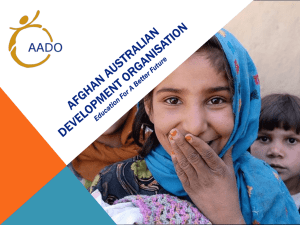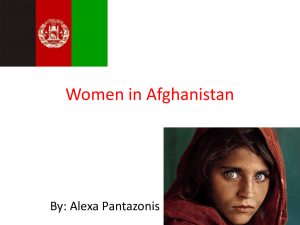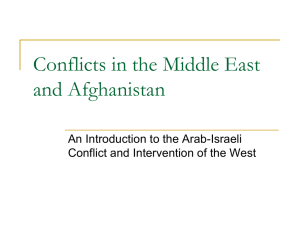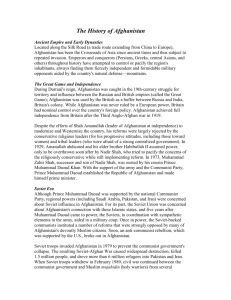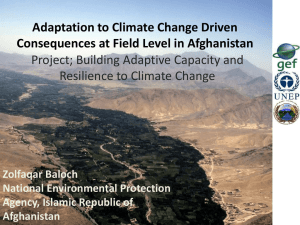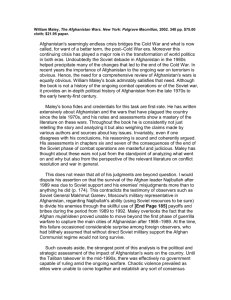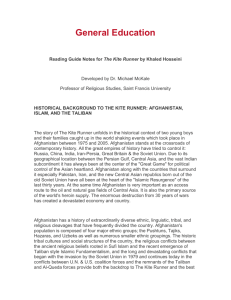Introduction to Afghanistan for Twin Schools
advertisement
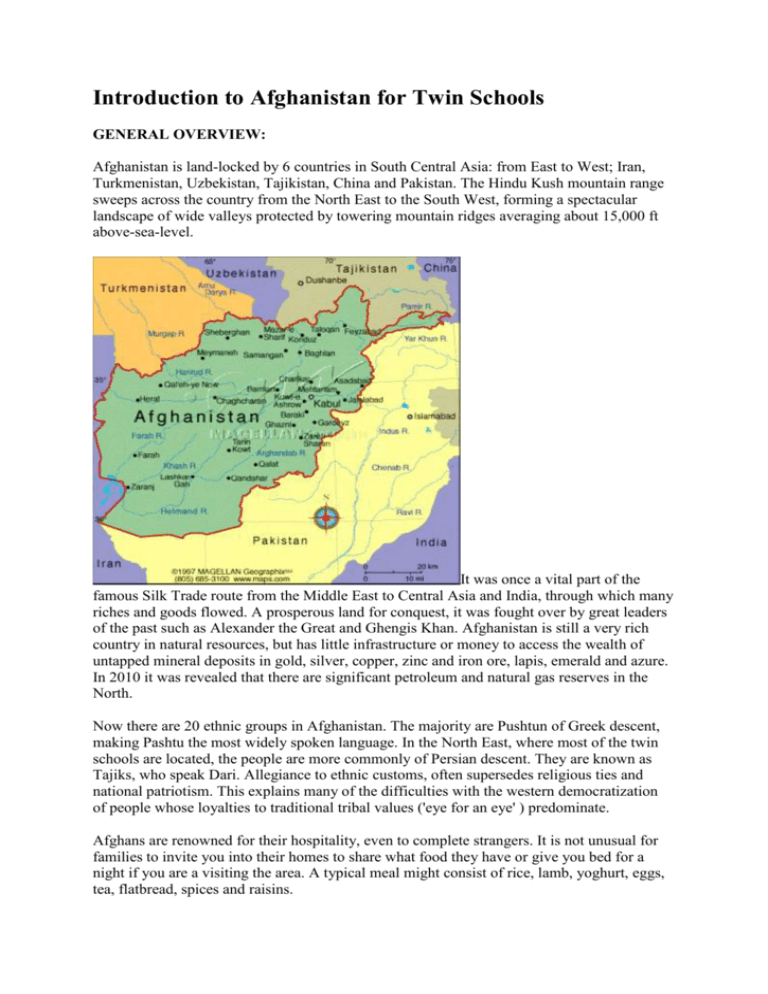
Introduction to Afghanistan for Twin Schools
GENERAL OVERVIEW:
Afghanistan is land-locked by 6 countries in South Central Asia: from East to West; Iran,
Turkmenistan, Uzbekistan, Tajikistan, China and Pakistan. The Hindu Kush mountain range
sweeps across the country from the North East to the South West, forming a spectacular
landscape of wide valleys protected by towering mountain ridges averaging about 15,000 ft
above-sea-level.
It was once a vital part of the
famous Silk Trade route from the Middle East to Central Asia and India, through which many
riches and goods flowed. A prosperous land for conquest, it was fought over by great leaders
of the past such as Alexander the Great and Ghengis Khan. Afghanistan is still a very rich
country in natural resources, but has little infrastructure or money to access the wealth of
untapped mineral deposits in gold, silver, copper, zinc and iron ore, lapis, emerald and azure.
In 2010 it was revealed that there are significant petroleum and natural gas reserves in the
North.
Now there are 20 ethnic groups in Afghanistan. The majority are Pushtun of Greek descent,
making Pashtu the most widely spoken language. In the North East, where most of the twin
schools are located, the people are more commonly of Persian descent. They are known as
Tajiks, who speak Dari. Allegiance to ethnic customs, often supersedes religious ties and
national patriotism. This explains many of the difficulties with the western democratization
of people whose loyalties to traditional tribal values ('eye for an eye' ) predominate.
Afghans are renowned for their hospitality, even to complete strangers. It is not unusual for
families to invite you into their homes to share what food they have or give you bed for a
night if you are a visiting the area. A typical meal might consist of rice, lamb, yoghurt, eggs,
tea, flatbread, spices and raisins.
Some common Pushtun phrases:
Hello ~ salaam
Welcome ~ pikheyr
How are you? ~ tsenga yee?
Good ~ sheh yem
Thank you ~ manana
GENERAL HISTORY:
In the last two centuries Afghanistan has fallen prey to a series of geo-strategic conflicts,
located between forces of Western and Eastern dominance. The Soviet invasion in 1979,
sparked the countries latest descent into war. Under Soviet Occupation much of the country
was mobilized into modernizing efforts, largely resented by the Afghan people, who felt
robbed of their identity and values. Following the Soviet defeat, the country fell into disarray
as rival tribal warlords and mujahideen factions (resistors to the communist rule) wrestled for
control. In 1994 the Taliban, a fundamentalist Islamic group rose in dominance, first taking
control of Kandahar. Located in the South, the city is still to this day the Taliban stronghold,
where much of the fighting takes place.
Under the Taliban much of the progress made in education was eroded, regarded as a symbol
of western domination in conflict with the values of Islam. One of our girls schools Shar-iKhona was bombed by Taliban in the 1990's. Since then we have re-built one block and when
demand grew we built an additional block for the school, which now educates about 1500
girls.
This was not always the case in Afghanistan. Before the Talibans rule in the 90's it was not
uncommon to graduate from university.
When the twin towers collapsed across TV screens all over the world in 2001, 9/11, the UK
and US military decided to go to war against the Taliban on grounds of national security. It
was believed that the terrorist cell responsible for 9/11 had links with Afghanistan, in
particular Al Queda the extremist Islamic group of Osama Bin Laden.
AFGHANISTAN AT PRESENT:
After 30 years of war, more than half of Afghanistan’s 27.1 million population are under 18
and have never known their home land without the shadow of war. The toil of war has
permanently destroyed cultural sites, damaged infrastructure and ultimately pushed people
into desperate impoverishment and hunger. Life expectancy in Afghanistan is 44 yrs, almost
half of the UK’s which is roughly 80 yrs, and more than half of all children under five (54%)
have growth problems due to malnutrition.
EDUCATION:
MDG2: Every child must receive primary education. This aim is being doggedly pursued
by many governments and non-government organizations like AC in Afghanistan. Nearly 8.5
million children are now receiving education in contrast to 1 million in 2001. AC supports
40,000 of these children.
But there are still many socio-cultural factors that make it difficult for children to
receive an education
- Distance: For many children it is too far for them to walk to school
Most children have to walk several hours to get to school, especially in rural areas with
poorer infrastructure. Often the mountainous landscape or harsh climate in winter and
summer make it impossible for children to reach their schools in time for morning classes.
- Lack of staff: Teacher-training is essential to AC's work in helping children receive an
education.
There is no point in providing classrooms and resources for children without a teachers
direction. The quality of teaching is another issue, since only 22% of trained teachers reach
the minimum teaching standard qualification set by the Ministry of Education.
- Security: It may be too dangerous for children to travel there
Land mines, bombing and gun-fire pose daily threats for children who may have to travel far
to school. The fighting does not always occur on specific front-lines but flares up in areas
with little warning, so parents often decide it is not worth taking the risk.
- Impoverishment: They may need to work to support their family
Many girls spend their days weaving rugs, as their small hands are perfect for the intricate
weaving work. These are valuable commodities abroad but this industry still only makes up a
minor part of the Afghan economy and can prevent young girls from receiving an education.
- Religious and traditional values: Some parents forbid their children, particularly girls, an
education due to fundamentalist religious beliefs
The Taliban still exercise control in many regions of the South and depending on who has
control in a given area parents might prefer to send children to a Madrassa religious school,
where children learn Islamic values and practices through close study of the Qu'ran.
~
At the beginning of 2011, Sarah Fane received a letter from one of the girls studying at Bibi
Ayisha High School, in N.E. Afghanistan, which shows how much an education means to girls
in Afghanistan;
'The best memory in my life is this one - so one day a kind and best woman came to our country and
she built a good and nice school for us. Now we are very happy because we have a good and nice
school in our Province and all of the girls can go to this school and study their lessons. Thank you
kind and lovely woman'
In their spare time children like to build and fly kites and enjoy many of the sports that
children do in the UK such as cricket and football. Girls like skipping, playing volleyball and
they are also skilled in embroidery, crocheting and beadwork which they often send to their
twin schools in the UK.
~
(Sources: DFID/SCA)


